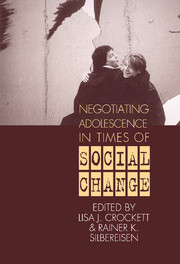Book contents
- Frontmatter
- Contents
- Contributors
- Preface
- 1 Social Change and Adolescent Development: Issues and Challenges
- Part I Models of Social Change Effects
- Part II Social Change and Adolescent Transitions
- Part III Social Change and Adolescents' Social Contexts
- Part IV Implications of Social Change for Adolescent Health and Well-Being
- 13 The Role of Economic Pressure in the Lives of Parents and Their Adolescents: The Family Stress Model
- 14 “Spread Your Wings and Fly”: The Course of Well-Being and Substance Use During the Transition to Young Adulthood
- 15 What Is a Cohort and Why? An Old Question Revisited
- Part V Interventions: Promoting Healthy Development in Times of Social Change
- Endnotes
- Index
14 - “Spread Your Wings and Fly”: The Course of Well-Being and Substance Use During the Transition to Young Adulthood
Published online by Cambridge University Press: 26 January 2010
- Frontmatter
- Contents
- Contributors
- Preface
- 1 Social Change and Adolescent Development: Issues and Challenges
- Part I Models of Social Change Effects
- Part II Social Change and Adolescent Transitions
- Part III Social Change and Adolescents' Social Contexts
- Part IV Implications of Social Change for Adolescent Health and Well-Being
- 13 The Role of Economic Pressure in the Lives of Parents and Their Adolescents: The Family Stress Model
- 14 “Spread Your Wings and Fly”: The Course of Well-Being and Substance Use During the Transition to Young Adulthood
- 15 What Is a Cohort and Why? An Old Question Revisited
- Part V Interventions: Promoting Healthy Development in Times of Social Change
- Endnotes
- Index
Summary
The period between adolescence and adulthood represents a critical developmental transition. Diversity in life paths becomes more clearly manifest during this transition (Sherrod, Haggerty, & Featherman, 1993), and interindividual variability in the timing and content of developmental milestones increases. This greater diversity is due to the realization of life path preferences established before the transition as well as to the creation of newpaths as a function of experiences during the transition. The emergence of new roles and social contexts provides increased opportunities for successes and failures, which in turn may set the stage for potential discontinuity in functioning between adolescence and young adulthood (e.g., Aseltine & Gore, 1993; Petersen, 1993; Schulenberg, Wadsworth, O'Malley, Bachman, & Johnston, 1996).
At the broader societal level, there is relatively little institutional structure to facilitate the transition to young adulthood (Hamilton, 1990; Hurrlemann, 1990). For example, there is far less institutionally and culturally imposed structure on the roles, experiences, and expectations of young people when they make the transition out of adolescence compared with when they make the transition into adolescence. This relative lack of structure is undoubtedly developmentally beneficial for some older adolescents. For others, however, the lack of structure creates a developmental mismatch that adversely influences their health and well-being (see, for example, Eccles et al., 1997; Lerner, 1982; Schulenberg, Maggs, & Hurrelmann, 1997).
Moreover, as Clausen (1991), Elder (1986), Mortimer (1992), and Schuman and Scott (1989) have shown, decisions and experiences during this transition can have powerful reverberations throughout the course of one's adulthood.
- Type
- Chapter
- Information
- Negotiating Adolescence in Times of Social Change , pp. 224 - 255Publisher: Cambridge University PressPrint publication year: 1999
- 1
- Cited by

